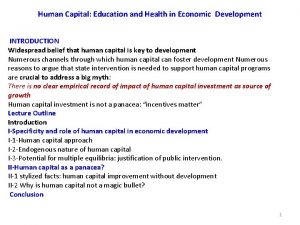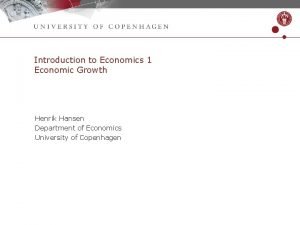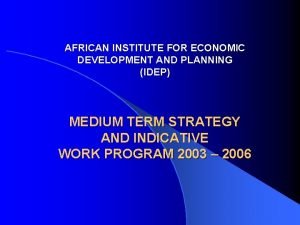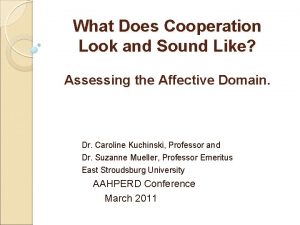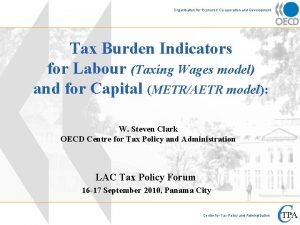Organisation for Economic Cooperation and Development Italian Confederation

















- Slides: 17

Organisation for Economic Co-operation and Development Italian Confederation of Employers Conference on Employment and Competitiveness Genoa, 24 -25 September 2010 The twin challenges of the jobs crisis and building new skills for new jobs John P. Martin Director, Employment, Labour and Social Affairs OECD, Directorate for Employment, Labour and Social Affairs

The jobs crisis § An unprecedented crisis • OECD-area UR jumped from 25 -year low of 5. 8% at the end of 2007 to a post-war high of 8. 8% in October 2009. Since then, it has remained fairly stable (8. 5% in July 2010), close to the rate in Italy (8. 4%) § While recovery is underway, the jobs crisis is far from over • OECD UR projected to show little change this year, before beginning to drop slowly through next year, but still to be around 8% by end 2011 • OECD’s Interim Economic Outlook (9 Sept. ) suggests that world economic th recovery is more fragile than previously anticipated

The current jobs crisis is the worst in recent decades Index base 100 = OECD area unemployment rate at the preceding business-cycle peak (based on output gap), quarterly data 1973 Q 2 1979 Q 2 1990 Q 1 2000 Q 2 2007 Q 3 Projected 160 150 140 130 120 110 100 90 0 1 2 3 Source: OECD Economic Outlook, May 2010. 4 5 6 7 8 9 10 11 12 Quarters elapsed since the beginning of the recession

The unemployment impact so far differs greatly across countries Percent of the labour force * March 2010 for Greece; April 2010 for Turkey; May 2010 for the United Kingdom; June 2010 for Chile, Estonia, Mexico, Norway and the Netherlands; and 2010 Q 2 for Iceland, New Zealand Switzerland (OECD harmonised unemployment rate data are not available on a monthly basis for the last three of these countries).

Who have suffered the most during the recent recession? Percentage change of employment over 2007 Q 4 to 2009 Q 4 Panel A. OECD weighted average Panel B. Italy

Labour market policy challenges § Short-term challenges vary a lot across countries • Providing an adequate safety net to the unemployed, including the LTU • Providing effective re-employment services. • What to do with the unemployed when labour demand is weak? • Is the work-first approach recession-proof? • Maintaining viable employment/promoting job creation. • How to sustain effective labour supply? § Minimise the risk of persistent LTU in those countries which have experienced sharp jumps in UNR 6

Providing an adequate safety nets while minimising benefit dependency § The jobs crisis is leading to longer average unemployment spells Where unemployment benefit durations are short, temporary extension during the crisis helps reducing the poverty risk among the long-term unemployed. Extension of benefits in e. g. Canada, Finland, Japan, Portugal and United States; • § Increasing numbers of ineligible jobseekers due to the increase in nonstandard work in some countries • Some countries have extended coverage to temporary and/or young workers, e. g. Finland, France, Japan; Italy introduced a lump-sum payment to unemployed former project contract workers 7

Need to adjust activation strategies during the jobs crisis § Threats to previously successful strategies: • DNK and SWI are the only two countries where resources for ALMP increase almost automatically with unemployment. . . • . . . in other countries in the past, PES staff and ALMP funds did not increase much in downturns, but this time there has been a stronger response • Risk for intensity of interventions in the unemployment spell (job search controls; in-depth interviews; action plan follow-up…) to decrease, and, given lower vacancies, a lower number of direct referrals. § Overriding goal: prevent job losers from becoming disconnected from the labour market • Core element of activation regimes and mutual obligation principle should not be allowed to lapse or be overly diluted • Adequate increase in resources is needed to: • • 8 handle client flows and maintain the range of PES interventions compensate for the fall in vacancy notifications by scaling up short-term programmes such as job clubs, work trials or internships

Need to ensure that S-T measures to support labour demand are well targeted and temporary § Most OECD countries have introduced measures to support labour demand: • • • § 9 Subsidies for the reduction in working time (22 countries, including ITA with CIGO/CIGS); Reductions in non-wage labour costs (16 countries); Hiring subsidies and work experience, generally targeted at disadvantaged groups (15 countries). When and how to scale down labour demand support measures? • • By protecting job matches these measures have reduced socially and economically inefficient job losses … …but risk increasing dualism (U highly concentrated on already disadvantaged groups and new entrants). . . …. and slow-down efficiency-enhancing labour reallocation Hiring subsidies may help promoting employment for disadvantaged groups, but have to be well targeted and with strict conditions for employers.

Annual average stock of employees participating in short-time work schemes as percentage of all employees 6 2009 2007 5 4 3 2 1 Data on short-time workers are from the OECD-EC questionnaire, except in the following cases. • * indicates that data are from national sources. 10 • ** indicates that data are OECD estimates using flows data from the OECD-EC questionnaire or from national sources. * BE L R TU ** A IT DE U LU X * JP N * N FI * ** CZ E CH E ** L IR ** ** ES P HU N * * ** SV K FR A D NL AU T R NO R KO * ** DN K A CA N US NZ L ** PR T PO L ** 0

Country-specific impact of short-time work schemes on permanent workers Proportional and absolute changes in permanent employment due to short-time work schemes (percentage changes) Percentage difference in permanent employment due to short-time work scheme % Absolute number of permanent jobs saved (right-hand side) 1, 4 420 000 1, 2 360 000 1 300 0, 8 240 000 0, 6 180 000 0, 4 120 000 0, 2 60 000 0 0 NOR 11 PRT DNK FRA NLD* HUN* AUT ESP CZE* DEU ITA FIN JPN BEL * indicates countries that introduced a new short-time work scheme in response to the crisis. The estimated jobs impacts refer to period from which the short-time work scheme became operational until the end of 2009 Q 3.

Going forward: the skills investment imperative Skills for mobility and sustainable growth ü Skill development is crucial to renewing economic growth on a balanced and sustainable basis: Ø The crisis has intensified longer-term shifts in skills as blue-collars have been hit harder than white-collars Ø And youth and low-skilled most at risk of being left behind in the recovery ü Growing importance of lifelong learning so that workers can upgrade their skills to cope with population ageing, globalisation, climate change Ø But tackling inequalities in training is difficult ü The crisis has also reinforced the message that we will need to be more jobmobile than in the past. Acquiring a range of generic skills can prove to be a life insurance against prolonged unemployment and help displaced workers find new jobs 12 Ø But which generic skills are most useful? Ø How can more comprehensive and rapid information on skill demands be provided?

Going forward: the skills investment imperative (cont. ) Identifying key skills ü Skills needs are evolving towards high -skilled jobs -- but some evidence of polarisation (i. e. hollowing-out of skill distribution of jobs) ü Need for better information on skill requirements of jobs, e. g. importance of: Ø Routine versus non-routine tasks Ø Hard skills versus soft skills ü Considerable challenge for education and training systems to adapt to these changes in skill demands Ø Need to strengthen links with employer organisations 13 Chart 1. Change in labour demand in terms of routine and non-routine tasks, United States

Going forward: the skills investment imperative (cont. ) Better utilising skills and anticipating future skill needs ü Important challenge to better utilise existing stock of human capital Ø E. g. women and older workers may face employment barriers because of family responsibilities, early retirement measures and poor working conditions ü Need to expand skill investments for mid-career workers ü Need to anticipate future skill needs: Ø Expanding workforce in health and long-term will raise issues of appropriate skill mix (general versus specialist skills in medical care) and the transferability of qualifications (especially for immigrants) Ø Green jobs are likely to expand but again need for better information on what types of skills these jobs will require 14

Improving the knowledge base The OECD Programme for the International Assessment of Adult Competencies (PIAAC): a new window on adult skills ü Household-based survey of population 16 -65 (minimum of 5000 respondents per country) to be held in 2011 -2012 ü 28 (mainly OECD) countries participating incl. Italy Literacy, numeracy & problemsolving skills Skills used at work PIAAC will extend and improve on the work of previous international surveys of adult skills by: ü Expanding direct assessment to problem-solving skills in context of IT and component literacy skills ü Extending skill measures to broader range of skills used at work Skill formation & labour market and social outcomes ü Tightening focus on links between skills and labour market outcomes Ø Determine importance of “soft” skills ü Measuring comparably both formal and less formal training and barriers to training 15

Concluding remarks § OECD countries are facing a deep jobs crisis, but the nature of the crisis and policy challenges vary significantly across the board § Recent LM policy reforms may have helped to deal with the rapid rise in unemployment but a number of issues remain: • • § A longer-term strategy of investing wisely in skills is also needed to ensure recovery from the crisis is converted into balanced and sustained growth • • 16 Administrative capacity to scale up LM programmes and possible role of private providers How to help those unemployed who are not eligible for income support schemes Discretionary LM policy measures should be timely, temporary and targeted The severe economic downturn could be an opportunity to invest in labour market institutions This requires better data on training and skill needs, more evaluations of existing skill development programmes and sharing of experiences across countries. The OECD’s PIAAC survey will help fill these knowledge gaps as well as its ongoing assessment of students (PISA) and its reviews of VET, tertiary education and regional skill strategies

www. oecd. org/els/employment/outlook 17
 Prof. meier and baldwin
Prof. meier and baldwin Apec forum
Apec forum Economic cooperation examples
Economic cooperation examples Economic growth vs economic development
Economic growth vs economic development Agriculture cooperation and farmers welfare
Agriculture cooperation and farmers welfare Economics unit 1 lesson 2 difficult choices
Economics unit 1 lesson 2 difficult choices Human capital education and health in economic development
Human capital education and health in economic development Economic growth and development
Economic growth and development Ministry of economic development job creation and trade
Ministry of economic development job creation and trade African institute for economic development and planning
African institute for economic development and planning What does cooperation sound like
What does cooperation sound like Example of cooperation in social interaction
Example of cooperation in social interaction International laboratory accreditation cooperation
International laboratory accreditation cooperation European co-operation for accreditation
European co-operation for accreditation Cooperation relationship ecosystem
Cooperation relationship ecosystem Offer for cooperation
Offer for cooperation Interamerican accreditation cooperation
Interamerican accreditation cooperation Unit 4 task 2
Unit 4 task 2






